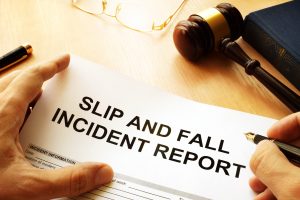If you suffer a Florida slip-and-fall injury, compensation requires more than proving you were hurt on someone else’s property. In fact, these cases are quite a bit more complicated than many people assume. A key element in a Florida slip-and-fall case is something called “constructive notice.” This is outlined in F.S. 768.0755, and was recently explained in a decision by the U.S. Court of Appeals for the 11th Circuit (the federal court with jurisdiction over Florida). 
The law requires those in slip-and-fall cases to prove the defendant property owner/manager had actual or constructive knowledge of the danger. Actual knowledge would be proof that they knew about that particular spill or hazard and hadn’t taken reasonable steps to rectify it. This is often tough or impossible to prove. Constructive knowledge, however, can be established by showing that either:
- The condition existed for such a period of time that the business should have learned about it if they were using ordinary care.
- The condition occurred so regularly and it was foreseeable.
In the recent case before the 11th Circuit, court records show the plaintiff slipped and fell on what was believed to have been a puddle of milk in a Target store in Boynton Beach. It happened in the stationary aisle. She struck her head on a shelf, began bleeding from the head and suffered serious injuries. Employees described finding her lying on the ground in a puddle of white liquid, as well as blood. She realized she was all wet, and that the liquid in which she’d slipped was warm to the touch.
The puddle was about 2-3 feet wide. A store employee took pictures of the scene after paramedics removed the plaintiff. The pictures showed a random assortment of items (bloody towels, gloves, glue, an envelope, etc.). One footprint was seen in the spill.
It was noted at trial that store employees are trained to watch for spills, pick up items if they’ve fallen and stay at the site if they notice a spill that needs cleaning. The store also designates certain workers to monitor specific parts of the store. Nobody could say when this spill happened. An employee walked through the aisle in question 30-45 minutes before the fall and didn’t see any liquid.
The plaintiff sued alleging failure to correct a dangerous condition. Following discovery, the store moved for summary judgment, arguing neither actual or constructive knowledge had been established. The plaintiff opposed the motion, arguing genuine issues of material fact from which jurors could reasonably infer the puddle was there for enough time the employees should have known about it. She cited the temperature of the liquid, the lack of an inspection policy, the size of the puddle and the footprint that was photographed.
The trial court granted summary judgment favoring the defense, finding the claim of no inspection policy mischaracterized the evidence and the footprint photographed was taken after numerous people had been walking through the scene. The court also held that the size of the puddle wasn’t indicative of how long it had been there and her evidence of the milk’s temperature was not sufficient of how long it had been there because she provided no evidence to substantiate how warm the milk was or how long it would take refrigerated milk to become warm. Her evidence, the court held, was conjectural and speculative.
The central question on appeal was whether the evidence supported the assertion that the company had constructive notice of the puddle (the plaintiff did not contend actual knowledge).
It’s well-established that the mere presence of a liquid on the floor isn’t sufficient enough to establish constructive knowledge. The evidence here showed the spill wasn’t there 30-45 minutes before the last employee walked by, but it could have happened moments after the employee left the aisle or moments before the plaintiff entered. But the court found the plaintiff didn’t present enough concrete evidence to indicate that it had been there long enough that employees should have known about it.
The size of a puddle could be indicative of how long it had been there – if one could show the source of the leak was, say, a trickle down a wall to the floor (as was the situation in the 1995 case of Erickson v. Carnival Cruise Lines, Inc. before Florida’s 3rd District Court of Appeal).
And even if the milk was warm, she presented no evidence that the milk wasn’t already warm when it was spilled. We might reasonably infer the milk came from the refrigerated aisle of the store, but how long it had been out before the spill is unclear. Inference based on speculation isn’t reasonable, the court noted.
Thus, the trial court’s grant of summary judgment was affirmed.
Plaintiffs in Florida slip-and-fall cases bear the burden of proof of showing constructive knowledge. Deficiencies like these can often be cured by presenting expert witness testimony on issues central to the case. The fact is, slip-and-fall accidents do occur regularly in stores, and in many cases, the store should have known the hazard was there and taken action to prevent people from being hurt. Our dedicated West Palm Beach injury lawyers are committed to helping you weigh the viability of your claim and, if we move forward, fully prepare for the task of meeting your proof burden.
Contact the South Florida personal injury attorneys at Halberg & Fogg PLLC by calling toll-free at 1-877-425-2374. Serving West Palm Beach, Miami, Tampa, Orlando and Fort Myers/ Naples. There is no fee unless you win.
Additional Resources:
Espinoza v. Target Corporation, et al., Jan. 19, 2021, U.S. Court of Appeals for the 11th Circuit
 South Florida Injury Lawyer Blog
South Florida Injury Lawyer Blog

